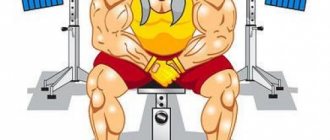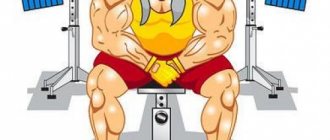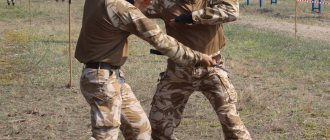This exercise was once included in the mandatory Olympic program for weightlifters. However, in pursuit of lifting maximum weight, participants increasingly began to push the barbell with their legs, using the whole body, instead of the classic bench press using arm strength. The last straw was the high risk of injury, since during the execution the athletes transferred the main load to the lower back, making it easier to lift the projectile. As a result, this discipline was removed from the competition program in 1972.
However, the exercise has successfully migrated from weightlifting to bodybuilding, is considered irreplaceable today and is included in the basic training program. When performed correctly, the military press does not pose any dangers, and the benefits in pumping up the shoulder girdle, especially the deltoids, are difficult to overestimate.
What muscles are involved?
Muscles receiving direct load:
- anterior bundle of deltoid muscle;
- middle bundle of deltoid muscle;
- triceps;
- periosteum muscle;
The following are auxiliary:
- trapezius muscle;
- top of the pectoralis major muscle;
- clavicular brachialis muscle;
- serratus anterior;
- biceps;
- press;
The more weight you take for work, the more intensively the auxiliary muscles are involved, for example, the abs, which receive a static load throughout the entire exercise.
Indirectly included in the work:
- posterior bundles of the deltoid muscle;
- latissimus dorsi muscle;
- splenius muscle;
- thigh muscle;
- shin;
- elbow muscle;
- gluteal muscle;
Auxiliary Exercises for the Military Press
Exercises of the 1st link
- Explosive Military Bench Press: 50-60% of max*3-5 reps*3-5 sets.
- Military bench press with limiters from the height of the dead center: X-weight * 3-5 reps * 3-5 sets.
- Bench press military style: X-weight * 5-8 reps * 3-5 sets.
- Military bench press with a long pause on the chest: X-weight * 6-10 reps * 3-5 sets.
- Military Barbell Bench Press with Bands/Chains: X-weight*3-8 reps*3-5 sets.
- Dips with additional weights: X-weight*5-8 reps*3-5 sets.
Exercises of the 2nd link
- Barbell/dumbbell bench press sitting/standing: X-weight*6-12 reps*3-5 sets.
- Bench press with medium grip: X-weight * 6-15 reps * 3-5 sets.
- Incline/reverse barbell/dumbbell bench press: X-weight*6-12 reps*3-5 sets.
- Any triceps exercises (example: reverse push-ups, lying arm extensions with a barbell or dumbbells, crossover arm extensions and others): X-weight * 8-15 repetitions * 3-5 sets.
- Any exercises for the chest (example: lying down, crossover, pullover and others): X-weight * 10-20 repetitions * 3-5 approaches.
- Any exercises for deltoids (example: front swings, bench presses, etc.): X-weight * 10-20 repetitions * 3-5 approaches.
Exercises of the 3rd link
- Pull-ups (variation of grips) with weights or body weight: X-weight*6-15 reps*3-5 sets.
- Exercises for the back muscles (example: horizontal/vertical rows in a machine, bent-over barbell/dumbbell rows, horizontal rows in a Hummer and others): X-weight*6-15 reps*3-5 sets.
- Hyperextension in the simulator and exercise variations: X-weight * 10-30 repetitions * 3-5 approaches.
- Exercises for the trapezius muscles (example: shrugs with a barbell/dumbbells and others): X-weight * 10-20 repetitions * 3-5 approaches.
- Biceps exercises (any variation of elbow curls with additional weights, such as biceps hammer, biceps curl with barbell/dumbbells, reverse grip biceps curl, etc.): X-weight*8-15 reps* 3-5 approaches.
- Exercises to strengthen the forearms (any exercises for grip strength, wrist flexion/extension).
- Exercises for the abdominal muscles.
Why is this exercise so popular?
Everyone wants to have broad and beautiful shoulders, so they often ask their trainers or look for some special techniques for their development. But in reality everything turns out to be much simpler! The deltoid muscle can perform two functions: “push” and “pull”, so to develop large, broad shoulders, it is enough to perform one exercise in each direction.
The military press in this sense is the most effective option for developing the pushing function of the shoulder; no other exercise can develop the delta as quickly as this. Also, due to the specifics of the execution (which will be discussed below), the triceps receives an absolutely unique load, which ensures an effective increase in its strength and mass. In addition, the body begins to actively produce stress hormones, which significantly enhance the effectiveness of the workout.
Disadvantages of the standard approach
One thing that drives me nuts is that some guys in the gym just can't grasp the basic principles. An overly stressful program is the main factor that prevents them from achieving success.
Here's an example of how they reason: “I just lifted 230kg! After a few times I’ll hit 270!”
Sorry, but first we should move on to the scales that fall between these two. These are 232, 235, 240, 250 kilograms, etc. If you lift the barbell with five weights, this does not mean that you will necessarily lift it with six! In fact, it could be a couple of years before you get to 270. And if you don't take your studies seriously, this process can take much longer.
A very modest and feasible task: increase weight by 5 kg every three months. This is 20 kg per year, 40 kg in two years and 60 kg in three, if we exclude all factors that can slow down this growth.
Of course, no one wants such a development of events; everyone wants to lift an extra 50kg today. Who has three extra years to gradually train?
So, this program sets itself a goal that is actually achievable: we increase weight by 5-7 kg in eight weeks, and this is a great success. 10kg or more? It would be a miracle. You can lift really heavy weights in your own time if you do one quality training cycle after another. Approach each exercise responsibly and one day you will find that you can easily lift the weight you could only dream of.
Cons of the military press
Perhaps the biggest disadvantage of this exercise is its high risk of injury. Mastering this press on your own is associated with great risk, because if the technique is set up incorrectly, subsequent work with heavy weights will inevitably lead to serious health problems.
The body is designed in such a way that it subconsciously acts with the least amount of force, and if it seems to it that it is easier to shift the load to the lower back, then it will do so, and you will notice this after receiving an injury. Therefore, it is recommended to study the military press only under the guidance of an experienced instructor. Be sure to strictly follow all the technical details and constantly monitor what you are doing, otherwise you will not get any benefit from this exercise at all.
Rules for competitions in the “Military Bench Press” division
Competitors perform bench presses without equipment (press shirts, sling shots) to a maximum weight in three approaches. Athletic belts and wrist wraps are permitted. The exercise is performed according to the accepted rules: The athlete must lie on his back, with his shoulders and buttocks in contact with the surface of the bench, his legs hanging, bent at the knees and crossed among themselves. The sole of his shoes should not come into contact with the surface of the bench. Legs should be crossed together. If during the exercise, the athlete straightened his legs and/or touched his feet to the bench, or put his feet on the floor, or spread his legs to the sides, then the judge must give the command “LEGS” and has the right not to count the approach/repetition.
The distance between the hands on the bar should not exceed 81 cm. The athlete, ONLY with the help of an assistant, removes the bar from the racks, lowers it until it touches the chest and waits for the senior judge’s signal. The signal must consist of a distinct command “Press”, “Start” (or “Press” - for the international version) and must be given as soon as the barbell reaches a stationary position on the chest. After receiving the signal, the athlete must press the barbell upward. The bar should not fall to the chest or make a downward movement while attempting to press the bar up, and should not stop while performing the press. The athlete must press the barbell with straight arms and hold it motionless. After fixing the bar in this position, the head judge must give a clear command “Rack” (or “Rack” - for the international version). The athlete returns it to its original position only upon the command of the “Stand” judge. The skew of the bar during upward movement should not be more than 10 cm. Any contact of the athlete’s feet with the bench, the floor or its supports is prohibited. During the exercise, there must be at least three assistants on the platform to belay the athlete. The presence of assistants should not prevent the judges from seeing the exercise being performed.
EQUIPMENT AND ITS SPECIFICATIONS
1. DAMN
The exercise must be performed on a platform that is at least 2.46m x 2.46m (8 x 8 ft). The surface must be durable, non-slip and completely flat in the part where the competitive exercises are carried out. The surface of the platform may be covered with rubber mats or other similar flooring material. During competitive exercises, the presence of persons other than the athlete, assistants, three judges and other officials is prohibited on the platform, if necessary. Any cleaning or installation of the platform should be carried out only by assistants. At all Championships and Cups of Kazakhstan, master tournaments and international competitions, there must be a podium for awarding athletes.
SPECIFICATIONS:
a) The neck must be straight, have good checkering or groove and meet the following measurements:
1. The total length of the bar should not exceed 2.2m. 2. The distance between the neck bushings should not exceed 1.32m and should not be less than 1.31m. 3. The diameter of the neck should not exceed 29mm and should not be less than 28mm. 4. The weight of the bar with locks should be 25 kg. 5. The diameter of the neck end sleeve should not exceed 52mm, and should not be less than 49.5mm. 6. The fingerboard should have circular notches, the distance between which should be 81cm.
b). Discs must meet the following requirements: 1. The difference between the marked weight of the disc used in competitions and its actual weight must not be more than 0.25% of its weight. 2. The diameter of the hole in the center of the disc must match the diameter of the bar to prevent unnecessary movement. 3. Discs of 1.25kg, 2.5kg, 5kg, 10kg, 15kg, 20kg, 25kg, and 50kg should be used. 4. All discs must be clearly marked with weight and must be installed on the bar in the following order: heavy discs on the inside (closer to the center of the bar), and smaller discs in descending order on the outside. 5. The very first and heaviest discs should be installed on the bar with their faces facing inwards, and the remaining discs – with their faces facing outwards. 6. The diameter of the heaviest discs should not exceed 45cm. 7. It is desirable that the color of the discs meet the following requirements: discs of 10 kg and less - any color, 15 kg - yellow, 20 kg - blue, 25 kg - red, 50 kg - green.
c) Locks
1. Must be used in competitions.
d) Miscellaneous. i. If traces of blood appear on the barbell or the athlete, they must be removed immediately. The rod must be disinfected with a 50% hydrogen peroxide solution
3. BENCH PRESS BENCH The bench press must be of a strong construction and provide maximum stability, and must meet the following requirements: a). The length should not be less than 1.22m. The bench should be smooth and positioned strictly horizontally. b). The width should not be less than 29cm and should not exceed 32cm. c). The height should not be less than 42cm and should not exceed 45cm. The height is measured between the floor and the top of the padded surface of the bench, and the padded surface should not be compressed in any way. d). The height of the height-adjustable bench posts should be a minimum of 82cm and a maximum of 100cm. The height of the posts of a non-adjustable bench must be a minimum of 87cm and a maximum of 100cm. This height is measured between the floor and the bar, which is on the racks. e). The minimum width between bench posts should be 1.10m. f). It is mandatory to use special “safe” bench press racks to prevent injury to the athlete if the barbell falls.
4. SAFETY
a). If the bar or equipment becomes contaminated with blood or other substances, it must be immediately cleaned with a 50% hydrogen peroxide solution. The bar or other equipment must be wiped dry. b). If an athlete becomes contaminated with blood or other substances, he must be treated immediately and the wound must be covered with a bandage to prevent further contamination of the bar or other equipment. COSTUME AND ITEMS OF PERSONAL EQUIPMENT All items of personal equipment and clothing of the athlete must be clean and free from scuffs and tears. Swearing in any language is strictly prohibited! Images of skulls, bones, demons, horns and other satanic designs on athlete’s clothing are also prohibited. Shorts. Shorts must be the same color as the T-shirt.
Tights.
It is mandatory to wear non-supportive tights at Republican competitions. It must be single-layer and be a single piece of clothing. The straps of the suit must be worn on the athlete’s shoulders during all exercises in competitions. The suit can be any color, plain or multi-colored. The suit must have legs that are no longer than mid-thigh (the midline defined between the crotch and the top of the kneecap). Women are permitted to wear a one-piece leotard that matches the required costume design. Leotards with sleeves or high-cut legs (like a leotard) are prohibited for use in competition. Wearing more than one suit is not permitted.
T-shirt.
Under a suit, it is allowed to wear one T-shirt (half-sleeve, T-shirt known as a “T-shirt”), with or without sleeves. It must be made from a single layer of fabric and be a separate item of clothing. Sleeves should not be below the elbows when the athlete’s arms are lowered. The jersey can be of any color, plain or multi-colored; inscriptions that are offensive or contrary to the spirit of the competition are not allowed.
Belt (belt).
The participant can use a belt (belt). It should be worn over tights.
Materials and design:
a) The belt is made of leather, vinyl or other similar, non-stretchable material from one or more layers glued and (or) stitched together. No metal parts other than those described below are allowed. b) The belt must not have additional soft padding, fastenings or supports of any other material outside or inside the belt. c) Buckle, rivets and stitching are the only non-leather parts allowed on the belt. The buckle should be attached to one end of the belt with rivets and/or sewn on. The belt should not have additional padding on the outside or inside the belt. d) The belt tongue loop must be attached to the belt in close proximity to the buckle by riveting and/or sewing. e) The name of the athlete, the name of the country or club for which he competes may be placed on the outside of the belt. f) The belt may have a buckle with one or two prongs (forks) or a special type of lever lock (carbine).
Socks.
Socks are permitted.
Shoes.
During exercises, the athlete, in addition to socks, must wear shoes. The only restrictions apply to shoes with metal spikes, straps or boots with weights.
Wrist bandages.
You can use bandages that do not exceed 1m in length and 8cm in width. Combining them with bandages is not permitted. The bandages may have a loop and Velcro fastener attached to them. The loop should not be worn while lifting the barbell. The width of the winding from the middle of the wrist up is no more than 10cm and down (on the hand) is no more than 2cm. The total winding width is no more than 12cm.
Plasters.
a) Two layers of medical tape can be applied to the thumbs. Do not use medical tape or its equivalent anywhere on the body without official permission. Medical tape or patches should not help the athlete hold the barbell in his hands. b) With the permission of the judges, the official doctor on duty or the paramedic on duty may apply a plaster or bandage to injured parts of the body. Likewise, medical plasters and bandages may be applied to palm injuries, but under no circumstances should these patches be wrapped around the palm.
General requirements.
a) The use of oil, ointments or other lubricants on the body, suit or equipment during the exercise is strictly prohibited. This does not apply to ointments and rubs used for therapeutic purposes. However, such means should not be noticeable during exercises. The use of dry magnesia is allowed. b) The use of any foreign substances on powerlifting equipment such as a platform, bench or bar is prohibited. c) All attributes of the athlete's uniform and personal equipment must be clean and tidy. In case of failure to comply with this requirement, the athlete, by decision of the judges, may not be allowed to further participate in competitions.
Table of standards
Attention! The standards for this exercise are for professional powerlifters.
| Weight category | Elite | MSMK | MS | KMS | 1st category |
| Up to 60 | 160 | 155 | 145 | 125 | 115 |
| Up to 70 | 175 | 165 | 150 | 135 | 125 |
| Up to 80 | 190 | 180 | 160 | 150 | 140 |
| Up to 90 | 200 | 190 | 165 | 155 | 150 |
| Up to 100 | 215 | 200 | 172.5 | 160 | 155 |
| Up to 110 | 225 | 205 | 177.5 | 165 | 160 |
| Up to 120 | 230 | 215 | 185 | 170 | 165 |
| Up to 130 | 240 | 225 | 195 | 177.5 | 170 |
| St. 130 | 250 | 230 | 200 | 182.5 | 175 |
Seated overhead press
Military press sitting behind the head
The exercise is aimed at working out the middle and upper delta bundles. Experienced athletes usually resort to it, since for beginners such a variation of the bench press is very traumatic, and instead of a positive result, it can “knock out” the neophyte for several weeks, or even months, from the training cycle.
The press is performed first on the day of shoulder training after a five to ten minute warm-up. The grip width should be greater than in the case of a classic military press performed from the chest. It is not recommended to use heavy loads when working with free weights.
Execution options
There are 7 implementation options in total, and although they have the same principle, there are still significant differences:
Classic version: standing barbell chest press
With this performance, all muscle groups receive a higher load than when performed in a sitting position. Also, from the point of view of unloading the lumbar region, this option would be preferable.
From the chest while sitting
It is better to master the military press from a standing position, and after gaining experience, you can move on to the seated version, which allows you to work out the shoulder girdle more efficiently.
Standing Dumbbell Chest Press
When performing an exercise with dumbbells, a large number of small muscles are used to maintain balance and control the direction of the stroke. It becomes possible to work with your hands alternately, which means it’s better to concentrate on each muscle.
From the chest while sitting
Working with dumbbells also allows you to use different weights for different arms, if, for example, one shoulder is more developed than the other and the asymmetry needs to be corrected.
From behind the head while standing
Allows you to diversify the load on the deltas by shifting the emphasis from the front beams to the middle ones. So the best choice is to include both variations in your program: both the chest press and the overhead press.
From behind the head while sitting
As in all previous versions, from a sitting position the stabilizing muscles are almost completely switched off from work. This makes it possible to lift heavier weights for work than in a standing position.
Military press on the Smith machine
Well suited for beginners who are just starting to master this exercise. What's good about this option? The fact is that, thanks to a special device, the barbell has only one axis of mobility, which allows you not to monitor the balance of the body, but to focus on technique.
Studies have been conducted on the distribution of load efficiency for a one-repetition maximum (this is the maximum weight that can be lifted at one time, without violating the technique of performing the exercise):
Standing: barbell/dumbbells
| anterior delta | average delta | biceps | triceps |
| dumbbells + 15% | dumbbells + 7% | barbell + 16% | barbell + 39% |
Seated: barbell/dumbbells
| anterior delta | average delta | biceps |
| dumbbells + 11% | dumbbells + 7% | barbell + 33% |
Sitting/standing position
| barbell: rear delta | dumbbells: rear delta | dumbbells: biceps | dumbbells: front delt | stay: triceps |
| standing press + 25% | standing press + 24% | standing press + 23% | standing press + 8% | standing press + 20% |
Federation
Competitions in this discipline are held by such federations as:
- FJD/Press Combined Federation: Military press max and multiple reps, as well as press combined (press max + multiple reps). Read more: Technical rules of the Federal Railways and Standards of the Federal Railways.
- NAP: Amateur and PRO divisions. Military press classic and military press multi-rep.
- ASM “Vityaz”: PRO division. Military press to the max.
Main exercise: standing military press
The execution technique deserves special attention, because if you do it correctly initially, then in the future it will save you from a lot of problems associated with possible injuries. Let's look at the main nuances.
Grip width
If you take it too wide, it will significantly reduce the amplitude of movement, and if it is narrow, the triceps will be very involved in the work, and our goal is the deltoids, so an average grip will be optimal.
Grasp the barbell correctly
We take a barbell shoulder-width apart and sit under it; to do this, we put one leg forward, rise up and slowly step back.
Starting position
The bar rests on your upper chest, your back is straight, your legs are slightly bent and shoulder-width apart.
Performing a movement
From the starting point, we smoothly lift the barbell up, and there is no need to watch it at this moment - throughout the entire exercise, the head is directed straight forward. Pay attention to the position of the legs: they always remain parallel to each other.
Breath
When lifting with effort, exhale. When lowering, we take in air.
Technical aspects
The military bench press is identical to the classic bench press. Its implementation involves the pectoral muscles, shoulder girdle, and triceps.
The legs are crossed and bent at the knees, hanging, the buttocks are pressed tightly to the surface of the bench, the shoulder blades are flattened, and the chest is pushed forward.
After taking the starting position on the bench, the apparatus is grasped with both hands, providing support only with the palms. The thumbs should be on top of the projectile, the maximum permitted grip is 81 cm (see photo).
The shoulder blades are brought together and lowered towards the pelvis to increase the degree of stability, tighten the pecs and reduce the range of motion (by pushing the chest forward), pressed against the bench. The barbell is removed from the racks, the arms are extended upward perpendicular to the bench, and the elbows are fixed. The position should be such that the bar is in line with the eyes (see photo).
By bringing the chest forward, a decrease in the amplitude of movement is achieved, and the level of effectiveness of the exercise increases (see photo).
The projectile is lowered diagonally (possibly in an arc) from the level of the shoulders (upper phase) to the lower section of the pectoral muscles/solar plexus area (lower phase). Raising the projectile is identical to lowering it along the trajectory of movement (see photo).
It is better to keep the elbow joints at an angle in relation to the torso. Tight elbows will impair movement mechanics, and perpendicular abduction to the sides will create an increased risk of injury. We take care of our wrists; they should not break, otherwise the mechanics of movement will be disrupted and the risk of injury will also increase (see photo).
We inhale in the starting position, before lowering the projectile. We hold our breath. Inhalation is done through the mouth. Through deep inhalation, a rigid structure of the upper body is achieved. We exhale at the top phase of the movement.
Seated technique
When performing a standing military press, you always have the option of simply throwing the barbell in front of you if something goes wrong. This cannot be done when you are sitting, so it is extremely important that someone supports you throughout the exercise.
Execution Features
The grip width is exactly the same as in the previous version; you can take it slightly wider than your shoulders.
The starting position remains the same, with the only difference being that now the legs rest firmly on the floor.
Execution technique : with the same smooth movement, we lift the projectile up while exhaling, and with inhalation, we lower it back to the chest.
If you do the exercise on a bench with a backrest , then its deviation from the vertical axis should not exceed 8-10 degrees, then the stabilizing load from the delta will be removed and it will be possible to work with more weight without violating the technique.
AWPC - Official Powerlifting Standards 2022
This article discusses standards tables for powerlifting in 2022 without equipment. Every athlete, regardless of their level of training, should focus on their strength indicators. The standards of three powerlifting federations are presented, in particular AWPC, IPF and WPC.
Athletes must complete 3 exercises in the overall competition:
- Bench press;
- Squats;
- Deadlift.
The athlete must perform the exercise with the maximum possible weight, which is required in order for the best result of 3 repetitions to be recorded in the final total.
Conditions for compliance with standards
1. The sports title of MSMK is carried out at sports competitions that have a status no lower than other international sports competitions included in the EKP (a unified calendar plan of interregional, all-Russian and international physical education events and sports events). 2. The sports title of MS is carried out at sports competitions with a status not lower than the championship of the federal district, two or more federal districts, championships of Moscow and St. Petersburg. Subject to random doping control and the presence on the platform of three sports judges who have the qualification category of a sports judge “sports judge of the All-Russian category.” 3. The sports title of Candidate of Masters is achieved at sports competitions that have a status not lower than the championship of a constituent entity of the Russian Federation. If there is on the platform one sports judge who has the qualification category of a sports judge “sports judge of the All-Russian category”, and two sports judges who have the qualification category of a sports judge “sports judge of the first category”. 4. I sports category is performed at sports competitions that have a status no lower than other official sports competitions of the constituent entity of the Russian Federation. 5. II-III sports categories, youth sports categories are performed at official sports competitions of any status. 6. Norms in sports disciplines containing the word “eventing” in their names are performed only by the sum of three exercises (squats, bench press, deadlift). 7. Russian championships, all-Russian sports competitions included in the EKP, among persons with an upper age limit, championships of the federal district, two or more federal districts, championships of Moscow, St. Petersburg, championships of a constituent entity of the Russian Federation, other official sports competitions of a constituent entity of the Russian Federation, among persons with an upper age limit, are held in age groups: juniors, juniors (19-23 years); boys, girls (14-18 years old). 8. Municipal championships and other official sports competitions of the municipality among persons with an upper age limit are held in the following age groups: juniors, juniors (19-23 years); boys, girls (14-18 years old); boys, girls (12-13 years old). 9. To participate in sports competitions, an athlete must reach the established age in the calendar year of the sports competition. 10. MSMK is awarded from the age of 17, MS - from the age of 16, CMS - from the age of 14, I-III sports categories and youth sports categories - from the age of 12.
What to pay special attention to
This is a barbell press, not a clean and jerk.
Often, beginning bodybuilders, mastering this exercise on their own, confuse its execution technique with pushing a barbell from the chest in a standing position. The fact is that the starting position is the same in both cases, and the push allows you to lift more weight with less effort. The upward movement of the barbell is carried out due to the extension of the legs, which gives it inertia, and then it is pressed to the top position by the force of the arms. As you can see, this is fundamentally different from the military press, where all the work is done by the delta.
Eliminate unnecessary movements
During execution, it is important to avoid unnecessary or incorrect movements, as this can lead to injury or “eat up” up to 90% of the effectiveness of the exercise. Key points to consider:
- The bar should not linger in the upper or lower position: as soon as the rise ends, the descent immediately begins.
- Don't try to push the projectile with your legs or chest at the beginning of the movement - this will steal the payload from your shoulders.
- Your gaze is directed strictly forward; you should not move your head while following the bar with your gaze, as this will cause you to bend your back backwards and overload your spine.
We monitor the position of the body, arms and legs
There should not be a situation where one leg is in front and the other is behind. This is done to ensure that the spine is balanced and there are no distortions. After all, when working with heavy weight, any distortion can immediately turn into injury.
The next point is body position. Under no circumstances should you lean back. As a matter of fact, this is why we are looking forward, so that such a desire does not arise. Often people lift a very heavy weight, and in order to help themselves with their chest, simplifying the exercise, they lean back. Always remember that the correct movement is performed by the deltoids, not the chest.
The wrists and forearm should be perpendicular to the floor and remain in this position throughout the entire range of motion. To do this correctly, you will have to take exactly the grip that was discussed above - shoulder-width apart. Otherwise, breaking tension will be created in the shoulder joints.
Work with “your” weight, don’t force it
You should increase the weight gradually, making sure that you can do the bench press technically correctly, without mistakes or unnecessary movements. There is no need to try to impress or prove something - start with light weights and achieve the correct technique, because in this exercise it plays a key role. Remember that your goal is beautiful broad shoulders and good health, not setting world records.
Don't neglect warming up
In any exercises with heavy equipment, you should never immediately take on the working weight, especially if your shoulders are involved in them, because they can very easily get a painful and very unpleasant tear.
- start your workout with cardio exercise, for example, with a short jog or on a stationary bike;
- perform bench presses with an empty bar or dumbbells 10-15 times;
- take a weight that is 30-35% of the working weight, do 15 repetitions;
- increase the load to 50% and perform 4-5 presses;
- Now your deltoids are warmed up enough and ready to move on to serious work - you can start doing working weights.
Benefits and harms
If you ask fitness experts about the benefits of exercise, opinions will be divided into two camps. Some will consider the military press an effective tool for building rounded deltas, others will advise only occasionally including it in the training plan. I would rather put myself in the second camp. And that's why:
- Despite the fact that many consider vertical presses to be a basic exercise for the middle deltoid, it is not the front deltoid that receives most of the load.
- Possible harm to the spine, especially for people with existing disorders. When you lower the barbell down and then stop for a moment at the bottom point, it tends to continue moving towards the floor by inertia. This is prevented not only by muscles, but also by joints, including intervertebral discs. They are like springs compressed under load and can be injured.
- A similar situation occurs with the shoulder joints. In the sitting version, the load on them increases. This occurs due to the exclusion of the legs from the work, which well absorb the inertia force of the barbell.
Now about the benefits:
- More stable position than in the standing version. This is good for beginners. It is also perfect for obese people who find it difficult to stand due to excess weight.
- Symmetrical load on the muscles. Firstly, this will lead to proportional development of the muscles of the left and right parts of the body. Secondly, such movements are technically simpler.
- The military press well strengthens the entire array of muscles in the shoulder girdle and arms.
You can get maximum benefits and minimize harm only if you use moderate weights. That is, those with which you are able to complete 12-15 repetitions with perfect technique.
What to do when there are certain problems
Unpleasant pain
Most often they occur in the shoulders or wrists, and sometimes the triceps may hurt.
- A common mistake that leads to pain in the wrist is bending it towards you when performing an exercise, while the correct position is strictly perpendicular to the floor. But, if this does happen, an elastic bandage will help you.
- If the delta is pulled, recovery may be delayed, so it is recommended to completely eliminate the load on this muscle and seek help from a doctor. The same goes for the triceps - give it a rest.
Problems maintaining balance
If in normal life your coordination is fine, but when you start doing the military press you have problems, then most likely you simply took on too much weight. At the same time, it is difficult to catch the balance point, you begin to be “led” and sometimes you just have to throw the barbell on the floor. There's nothing wrong with that, you're just not trained enough for that weight yet.
Lack of flexibility
It happens that people have some stiffness in the shoulder girdle. In this case, the correct execution technique becomes unnatural for them. You should never go against your own body, it will not lead to anything good. To increase shoulder mobility, try yoga, stretching, or exercise therapy.
Back and lower back pain
If you tried to work with heavy weights without raising your technique to the proper level, you may experience lower back pain. Therefore, never force the load, always monitor your technique and use a special athletic belt when doing bench presses. But, if it’s too late for useful advice and pain is already present, wear an orthopedic belt for the lower back.
If you have weak back muscles, standing barbell presses can cause pain. In this case, it is recommended to train the latissimus dorsi, trapezius and rhomboid muscles separately, and do the military press while sitting on a bench with a backrest.
How often to load the delta
The stronger the load, the more time the muscles need to recover. Overloading a muscle group will only lead to their overtraining, and you will be forced to interrupt your activities until the body is completely restored. If you give shock loads to the deltas, then next time it is recommended to work with them no earlier than after 10-12 days. In a normal training regime, this interval is 7 days.
In the following video you can watch the technique of performing the military press while standing and sitting:
If you do the same exercises and do not increase the weight, over time this will lead to the fact that the muscles will stop growing and you will simply maintain their tone. That’s why the military press, which has as many as 7 options, is so good. You have ample opportunities to combine loads and develop the deltoid muscles: when the weight limit in the standing press is reached, you can move on to the seated version.
More isolated work on the shoulder girdle, also with increased weight, will allow you to make a breakthrough and continue to increase working weight, and therefore build muscle mass. Remember that regular practice is very important. If you work technically correctly and without overloading, you will immediately feel how you become much stronger, and your shoulders widen and fill with mass.
What kind of exercise is this
Despite the name, this press is not directly connected with the army. But it got this name because in its original position the stance resembles a soldier’s.
The sitting option appeared later. In it, a person no longer has to stand, but can sit on a bench. Otherwise, the techniques of these two movements are similar.
What kind of “beast” is this? Any pressing movement involves pushing an object away from you in some direction. In our case, we push the barbell up while sitting on a bench.
The exercise is found not only in bodybuilding, but also in other sports. For example, in weightlifting and crossfit.
Advantages and disadvantages
The military bench press has the following advantages:
- Gaining expressive deltoid muscles.
- Energy consumption that guarantees fat burning.
- Obtaining basic training for the vast majority of other bench press exercises and for some power-speed exercises (cleans, jerks).
- Development of amplitude and flexibility of joints.
- Increase in overall strength and endurance of the upper body.
- More effective, uniform building of muscle mass than with strength training on simulators due to the involvement of almost the entire upper body in the process.
- Ensuring the prevention of problems associated with insufficiently active blood circulation in the cervical-collar area. It can provoke muscle spasms and persistent migraines.
The standing military barbell press allows you to relatively quickly tighten the muscles in your arms. Therefore, the exercise is often recommended for girls who want to tone them up.
A correctly performed bench press has no disadvantages. We can talk about disadvantages only in cases of technical violations. For beginners, falls are possible (the body simply falls back, unable to withstand the excessive weight taken).
There is a high risk of injury due to inadequate training volume. Wanting to get beautiful shoulder relief as quickly as possible, some people greatly overload them. The result is intense pain and even inflammation of soft tissues.
Other possible injuries include back injury due to the inability to stabilize the lower back in motion and weakness of the anterior abdominal wall. They are very serious - displacement of the vertebrae, hernia, protrusion. The hands can also be damaged if you hold the bar not as it should be, but in a way that seems more convenient.
The military press is an excellent base for many other pressing techniques.
This is the best way to quickly form beautiful deltoid muscles
This exercise develops a powerful shoulder girdle, allowing you to withstand heavy loads.
The military press is great for developing joint range and flexibility.
Smith machine press
Seated military press in Smith machine
The Smith machine is a kind of rack that limits the movement of the bar exclusively down or up. The overhead press on such a machine is performed virtually identical to the free weight exercise described above, but has a lower risk of causing harm to your own body. Therefore, beginners can be recommended to perform it according to the following algorithm:
- The bench is installed so that the bar is located directly above the seating area.
- Having fixed the barbell at a slight elevation from the head, you need to grab it so that the grip is wide enough and your elbows form an angle of 90 degrees.
- After removing the bar, you need to lift the barbell up, but unlike a free weight exercise, your elbows do not straighten completely.
You need to lower the bar slowly and very carefully. When the bar lowers to the level of the back of the head, it can be held for a moment. The number of repetitions per approach usually varies from 8 to 12.











